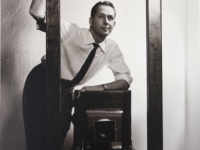Yousuf Karsh, (December 23, 1908 – July 13, 2002) was a Canadian photographer of Armenian heritage, and one of the most famous and accomplished portrait photographers of all time.
Yousuf or Josuf (his given Armenian name was Hovsep) Karsh was born in Mardin, a city in the eastern Ottoman Empire (present Turkey). He grew up during the Armenian Genocide where he wrote, “I saw relatives massacred; my sister died of starvation as we were driven from village to village.” At the age of 14, he fled with his family to Syria to escape persecution. Two years later, his parents sent Yousuf to live with his uncle George Nakash, a photographer in Sherbrooke, Quebec, Canada. Karsh briefly attended school there and assisted in his uncle’s studio. Nakash saw great potential in his nephew and in 1928 arranged for Karsh to apprentice with portrait photographer John Garo in Boston, Massachusetts, United States. His brother, Malak Karsh, was also a photographer famous for the image of logs floating down the river on the Canadian one dollar bill.
Karsh returned to Canada four years later, eager to make his mark. He established a studio in the Chateau Laurier Hotel in Ottawa, Ontario, close to Canada’s seat of government. Canadian Prime Minister Mackenzie King discovered Karsh and arranged introductions with visiting dignitaries for portrait sittings. Karsh’s work attracted the attention of varied celebrities, but his place in history was sealed on 30 December 1941 when he photographed Winston Churchill, after Churchill gave a speech to Canadian House of Commons in Ottawa.
The image of Churchill brought Karsh international prominence, and is claimed to be the most reproduced photographic portrait in history. Of the 100 most notable people of the century, named by the International Who’s Who [2000], Karsh had photographed 51.
In the late 1990s Karsh moved to Boston and on July 13, 2002, aged 93, he died at Boston’s Brigham and Women’s Hospital after complications following surgery. He was interred in Notre Dame Cemetery in Ottawa.
Karsh was a master of studio lights. One of Karsh’s distinctive practices was lighting the subject’s hands separately. Journalist George Perry wrote in the British paper The Sunday Times that “when the famous start thinking of immortality, they call for Karsh of Ottawa.”
Karsh had a gift for capturing the essence of his subject in the instant of his portrait. As Karsh wrote of his own work in Karsh Portfolio in 1967, “Within every man and woman a secret is hidden, and as a photographer it is my task to reveal it if I can. The revelation, if it comes at all, will come in a small fraction of a second with an unconscious gesture, a gleam of the eye, a brief lifting of the mask that all humans wear to conceal their innermost selves from the world. In that fleeting interval of opportunity the photographer must act or lose his prize.”





